48.3 Run Options Tab
The Run Options tab includes the following pages to help you configure how the application runs on the workstation:
48.3.1 Application Page
The Application property page is available only on Application objects created for simple applications, AOT/AXT applications, and MSI applications. It is not available on Application objects created for Web applications and terminal server applications.
The Application property page, shown below, determines general options to be used by Application Launcher when running the application on a workstation.
Figure 48-17 Application Object > Run Options Tab > Application Page
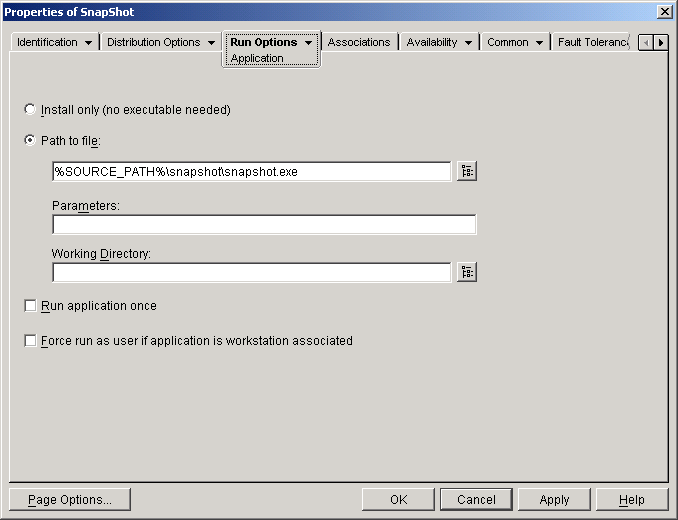
Install Only (No Executable Needed)
Select this option if the distribution does not include an executable file for Application Launcher to launch after the distribution. For example, you would want to use this option if the Application object’s only purpose is to update some files on the workstation, such as a driver or font, or to make modifications to some workstation settings, such as the registry settings.
Path to File
Enter, or browse for, the path to the executable that Application Launcher runs after the application is distributed. Typically, this path is defined when you create the Application object and should already contain the path to where the executable is located on the network or where it is located on the user’s workstation after distribution. If you enter the path, make sure to include the .exe extension on the application executable filename (for example, enter notepad.exe, not notepad).
IMPORTANT:The ZENworks Desktop Management Agent and Middle Tier Server do not support launching of applications from a network location. If the executable is located on the network, you should only use this option if users have a network client (Novell Client or Microsoft Client for Networks) installed that enables launching from a NetWare®, Linux, or Windows server.
You can also enter the path for a file type other than .exe. If you do so, when the user double-clicks the Application object, Application Launcher passes the file to the Windows system, which can then use the application associated with that file type to open the file. For example, if you entered a .txt file, the application associated with .txt files would be used to open the file.
You can use a mapped drive or a UNC path. The following path syntaxes are valid:
- server\volume:path
- \\server_name\volume\path
- \\IP_address\volume\path
- volume_object_name:path
- directory_map_object_name:path
- driveletter:\path
If you use a UNC path, applications running on Windows 2000 servers might launch slowly because of the way Windows resolves UNC paths. For more information, see Microsoft Knowledge Base Article Q150807.
You can also use macros in this field. For information about macros, see Section 49.0, Reference: Macros.
Parameters
Specify any command line parameters that need to be passed to the executable specified in the field. The field limit is 250 characters.
Application Launcher simply passes the parameters exactly as they are entered. Therefore, the parameter syntax you use must exactly match the syntax the executable requires. For example, if word.exe has a /f=filepath parameter that requires paths with spaces to be enclosed in quotation marks, you would enter the following:
/f=”c:\my docs\sample.doc”
Working Directory
Specify the working directory of the executable you specified in the field. Typically, this is the directory in which the executable file is located. However, if another directory contains additional files required by the application to run, specify that directory. See your Windows documentation for more information.
The following path syntaxes are valid:
- server\volume:path
- \\server\volume\path
- volume_object_name:path
- directory_map_object_name:path
- driveletter:\path
You can also use macros in this field. For information about macros, see Section 49.0, Reference: Macros.
Run Application Once
Select this option to have Application Launcher run the application one time only and then remove the Application object’s icon from the workstation. If the Application object’s version number ( > page) changes, the Application object icon appears again so that the new version can be distributed.
This option can be useful when an Application object’s only purpose is to install software to a workstation. Having the Application object’s icon remain after the application has been installed can be confusing to users, especially if you have an application shortcut or program group icon created during the distribution (see the > page).
This option can also be used in combination with other Application object settings. For example, if the application is specified as on the Associations page (meaning that without any user involvement, the application runs when it becomes available to Application Launcher), the application is forced to run only one time.
Force Run As User If Application Is Workstation Associated
With workstation-associated applications that are marked as ( tab > page), the Workstation Helper launches the application as soon as the workstation is started, typically before the user has logged in to Windows. This means that the only workstation-associated applications you would want to force run would be applications that don’t require user interaction.
Select this option if you want to delay the force running of a workstation-associated application until the user logs in to Windows and Application Launcher starts. Distribution of the application occurs in the workstation system space prior to the user logging in to Windows. After the user is logged in and Application Launcher starts, Application Launcher runs the application using the user’s credentials.
Because the distribution takes place in the workstation system space using the workstation’s credentials, you should not use any Application object distribution settings that are dependent on the user being logged in. For example, you would not want to have files copied to c:\%USERNAME% during the distribution, where %USERNAME% is the Windows environment USERNAME variable, because no user is logged in when the distribution occurs.
48.3.2 Environment Page
The Environment property page is available only on Application objects created for simple applications, AOT/AXT applications, and MSI applications. It is not available on Application objects created for Web applications and terminal server applications.
The Environment property page, shown below, defines the environment in which Application Launcher runs the application.
Figure 48-18 Application Object > Run Options Tab > Environment Page
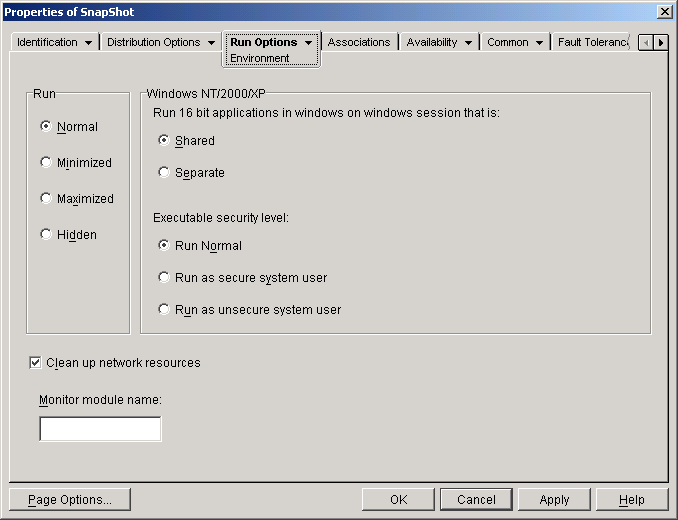
Run
Select the application’s initial window size: Normal, Minimized, Maximized, or Hidden. In Hidden mode, the application runs normally without a user interface available. This is useful if you want the application to process something then go away without user intervention. For example, you could use it for the Remote Control agent if you don’t want it to appear in the taskbar.
NOTE:Some applications cannot be run in Minimized, Maximized, or Hidden mode. Depending on the application, the initial window size setting might be ignored. For example, calc.exe cannot be run in Hidden mode.
Windows NT/2000/XP
Use these options to specify how the application runs on Windows 2000/XP workstations.
Run 16-Bit Applications in Windows on Windows Session That Is
If you are setting up a 16-bit application to run on Windows 2000/XP, specify either a shared or separate Windows on Windows (WOW) session. To run on Windows 2000/XP, 16-bit applications must run in a Virtual DOS Machine (VDM) that emulates Windows 3.1 functionality. 16-bit Windows applications can run in their own separate WOW sessions or they can share a WOW session with other 16-bit applications. Sharing a WOW session saves memory and allows applications to use DDE or OLE to communicate with other applications in the same WOW session. Running an application in its own separate WOW session allows for more robust operation because the application is isolated from other 16-bit applications. Because some applications do not run properly in a separate WOW session, the default option is to run the 16-bit Windows application in a shared WOW session.
Executable Security Level
On Windows 2000/XP, the application executable (as defined in the field on the Application Page) can run in either the “user” space or the “system” space. By default, the option is selected, which causes the application to run in the “user” space and inherit the same workstation security level as the logged-in user.
If the logged-in user's security level does not provide sufficient rights and file access to run the application, you can configure the application to run in the “system” space. The two “system” space options, as well as the (“user” space) option are described below:
-
Run normal: The application inherits the logged-in user’s credentials. For example, the application has the same rights to the registry and the file system as the logged-in user.
-
Run as secure system user: The application is run under the Local System user and inherits Administrator-level credentials. For example, the application has full rights to the registry and the file system. Because the security level is set to , the application's interface is not displayed to the user and the application is only visible in the Task Manager. This option is useful when running applications that require full access to the workstation but require no user intervention, such as a service pack or update.
-
Run as unsecure system user: This option is the same as , with the exception that the application's interface is displayed to the user. This means that the application can display dialog boxes and prompt the user for information if necessary. In return, the user has the ability to do whatever that application offers on the workstation. For example, if you run REGEDIT as an unsecure system user, the workstation’s user is able to edit any registry values.
In a terminal server environment, you should not use the and options if users are running Application Launcher in a terminal server client session. Doing so causes the NAL Service (running on the terminal server) to launch the application. Because the NAL Service runs as a System user, the launched application displays only in the terminal server's Task Manager (for ) or on the terminal server's desktop (). It does not display in the users' terminal server client sessions.
Clean Up Network Resources
Select this option to remove network connections, drive mappings, and port captures that were established for running the application. If this option is not selected, the network resources remain in effect. If the resource is already in use when Application Launcher starts the application, it is not cleaned up until all other distributed applications are finished using it. If distributed applications are still running when Application Launcher is terminated, the allocated resources remain intact.
Monitor Module Name
When an application is launched, Application Launcher monitors the executable of the application. When the executable terminates, the process of cleaning up network resources begins. However, it’s possible that the executable filename is actually a “wrapper” that sets up environments, runs other executables, and then terminates. If Application Launcher monitors the wrapper executable, it might prematurely start cleaning up network resources before the application has terminated. Consult your application documentation about whether the application uses a wrapper executable. If it does, find out the name of the module that remains running. Type this name (without the extension) in the text box provided.
48.3.3 Launch Scripts Page
The Launch Scripts property page is available on Application objects created for simple applications, AOT/AXT applications, and MSI applications only. It is not available on Application objects created for Web applications and terminal server applications.
As part of the process of launching the application, Application Launcher can launch a script engine to execute a “before launch” script and an “after termination” script (for details about the order of script execution, see Script Execution Order). The Launch Scripts property page, shown below, defines the script engine that you want Application Launcher to use and the scripts you want executed.
Figure 48-19 Application Object > Run Options Tab > Launch Scripts Page
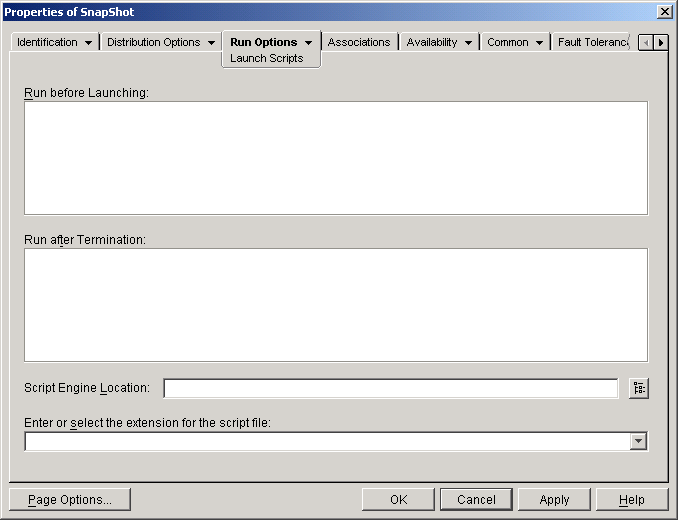
On Windows 2000/XP, launch scripts always run in the user space, meaning that they inherit the file system rights assigned to the logged-in user. This is true even if the application's executable is configured to run in the system space ( tab > page > option). This behavior is different than the behavior for distribution scripts ( tab > page), which run in the secure system space.
Run Before Launching
Use this text window to enter any script commands you want executed before launching the application. Do not use extended characters in the script; extended characters are not supported.
For a script example, see Script Example.
Run After Termination
Use this text window to enter any script commands you want executed after the user closes the application. Do not use extended characters in the script; extended characters are not supported.
For a script example, see Script Example.
The script is executed before the network resources are cleaned up ( > page). However, the option does not clean up drive mappings or port captures created by the script. To clean up these resources, enter the appropriate commands in the script.
Script Engine Location
The script engine determines the script commands and scripting language you need to use. If you do not define a script engine in the field, Application Launcher uses the Novell Client as the script engine (if the workstation has the Novell Client installed), which means that you can use most Novell Client login script commands (see Supported Novell Client Login Script Commands).
If you want to use a script engine other than the Novell Client, specify the script engine. The script engine must reside in a location that is always available to users, such as their local drives. The script engine can reside on a network server only if users can map a drive to the server (for example, through the Novell Client or the Client for Microsoft Networks). If Application Launcher cannot find the script engine, it displays an error to the user and fails to launch the application.
If you use the Windows command interpreter as the script engine, you must include the /c switch, as shown in the following examples:
-
Windows 2000/XP: %*winsysdir%\cmd.exe /c
-
Windows 98: %*windir%\command.com /c
The %*winsysdir% and %*windir% variables specify the Windows system directory (for example, c:\winnt\system32), and the /c switch instructs the command interpreter to execute the script and then stop. If the /c switch is not used, the script does not complete.
For a script example, see Script Example.
Script File Extension
This applies only if you specified a script engine in the field.
When the application is launched, Application Launcher creates temporary script files for the scripts and scripts. These files are passed to the script engine, which then executes the script. You need to specify the file extension that the script engine requires for its script files.
For a script example, see Script Example.
Script Example
The following script uses the Windows 2000/XP command interpreter as the script engine. Before the launch occurs, a listing of the c:\ directory is saved to a text file and the autoexec.bat file is backed up.
Run Before Distribution Field
dir c:\ >c:\1.txt copy autoexec.bat autoexec.bak /y
Script Engine Location Field
cmd.exe /c
Enter or Select the Extension of the Script File Field
.bat
Script Execution Order
Application Launcher can execute up to four different scripts when distributing and launching an application:
-
Distribution scripts: and ( tab > page)
-
Launch scripts: and ( tab > page)
Application Launcher executes the scripts in the following order:
-
Run Before Launching script executed
-
Run Before Distribution script executed
-
Application distributed (files copied, settings modified, etc.)
-
Run After Distribution script executed
-
Application launched
-
Application closed (by user)
-
Run After Termination script executed
Supported Novell Client Login Script Commands
When using the Novell Client as the script engine, you can use all but the following script commands:
Table 48-2 Supported Novell Client Login Script Commands
|
CLS |
INCLUDE |
PCOMPATIBLE |
|
DISPLAY |
LASTLOGINTIME |
SCRIPT_SERVER |
|
EXIT |
NO_DEFAULT |
SET_TIME |
|
FDISPLAY |
NOSWAP |
SWAP |
|
IF MEMBER OF |
PAUSE |
WRITE |
Application Launcher does not output anything to the screen or display script errors.
For script commands, syntax, and examples, see the Novell Client documentation on the Novell Documentation Web site.
48.3.4 Environment Variables Page
The Environment Variables property page is available only on Application objects created for simple applications, AOT/AXT applications, and MSI applications. It is not available on Application objects created for Web applications and terminal server applications.
The Environment Variables property page, shown below, specifies the environment variables that Application Launcher sets before running the application. For example, you can specify the application’s working directory in the PATH environment variable.
Figure 48-20 Application Object > Run Options Tab > Environment Variables Page
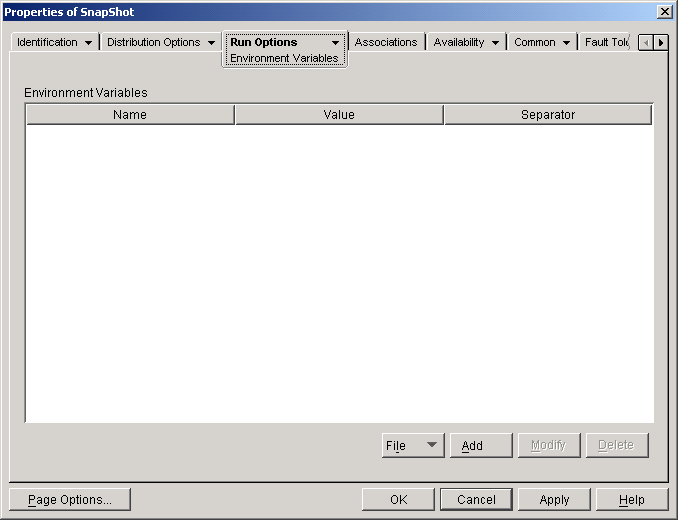
IMPORTANT:On Windows 98 workstations, Application Launcher cannot set environment variables if the Novell Client is not installed. This is not an issue on Windows 2000/XP workstations.
Environment Variables
The Environment Variables list displays all variables that are modified before the application is run. Application Launcher modifies only the variables in this list.
File
This option lets you search for variables or variable data in the list and import variables from another Application object into the tree.
Click , then choose one of the following options:
-
Find: Searches for variables or variable data in the list.
-
Find next: Finds the next occurrence of the item specified by the initial search.
-
Import: Imports variables from another Application object’s .aot or .axt file. The Open dialog box defaults to *.axt for its file type display. If you are importing from an .aot file, you must change the file type display to *.aot or in order to select the .aot file.
Add
To add a variable to the list, click to display the Edit Environment Variables dialog box, specify the variable name and data, select (only if you want to append the data to the workstation’s existing variable) and enter a separator character, then click .
Modify
In the Environment Variables list, select the variable you want to modify, then click .
Delete
In the Environment Variables list, select the variable you want to delete, then click to remove it from the list.
48.3.5 Web URL
The Web URL property page is available on Application objects created for Web applications only. It is not available on Application objects created for simple, AOT/AXT, MSI, and terminal server applications.
The Web URL property page, shown below, specifies the location (URL) of the Web application.
Figure 48-21 Application Object > Run Options Tab > Web URL Page
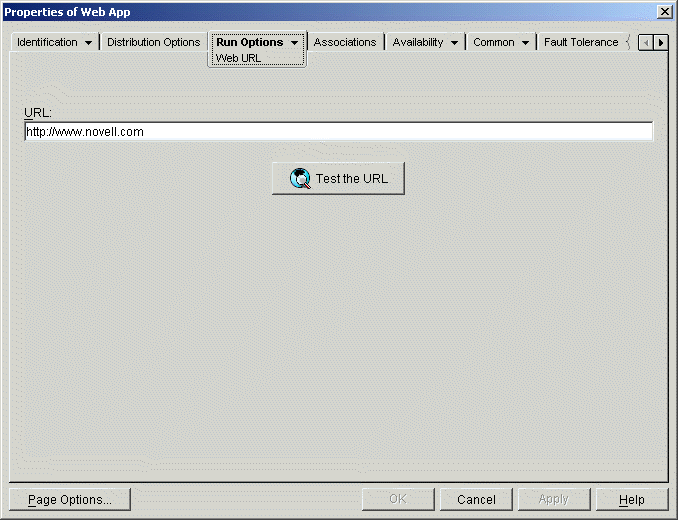
URL
This field defaults to the URL you entered when creating the Application object. The URL should point to the primary file for the Web application or to a Web page that allows access to the Web application. If necessary, you can modify the URL.
Test the URL
Click this button to launch the Web application. The current workstation must have a Web browser installed for this functionality to work.
48.3.6 License/Metering Page
The License/Metering property page is available on Application objects created for all application types (simple, AOT/AXT, MSI, Web, and terminal server).
The License/Metering property page, shown below, configures Application Launcher to use Novell Licensing Services to track application usage and comply with the application's licensing agreement. Novell Licensing Services must already be installed, you must have created a License Container and a Metered Certificate for the application, and users' workstations must be running the Novell Client. For detailed information about setting up license metering, see Section 45.0, Metering Software Licenses.
Figure 48-22 Application Object > Run Options Tab > License/metering Page
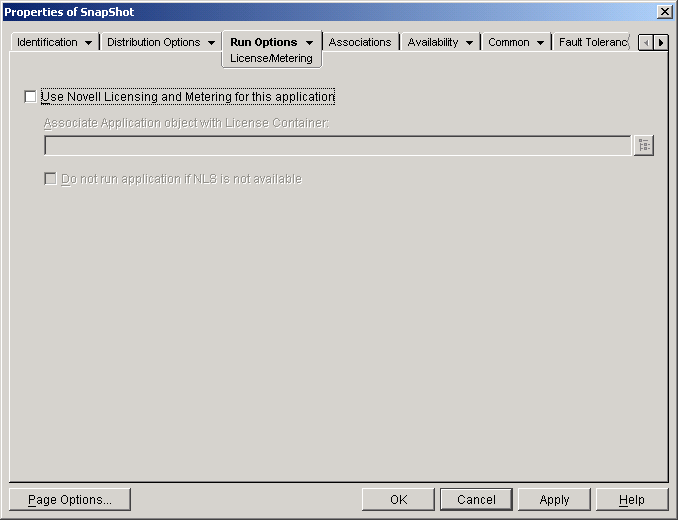
Use Novell Licensing and Metering for this Application
Select this option to enable metering of the application.
Associate Application Object with License Container
After metering is enabled, select the License Container in which you’ve created the application’s Metered Certificate.
Do Not Run Application If NLS Is Not Available
Select this option to prevent users from running the application if Novell Licensing Services is not running.
48.3.7 Application Dependencies Page
The Application Dependencies property page is available on Application objects created for all application types (simple, AOT/AXT, MSI, Web, and terminal server).
This section provides information about the fields located on the Application Dependencies property page. For complete instructions on setting up application dependencies, see Advanced Distribution: Configuring Application Dependencies and Chains.
The Application Dependencies property page, shown below, lets you create a list of applications (referred to as dependent applications) that must be distributed and launched before this application (referred to as the primary application) is distributed and launched.
Figure 48-23 Application Object > Run Options Tab > Application Dependencies Page
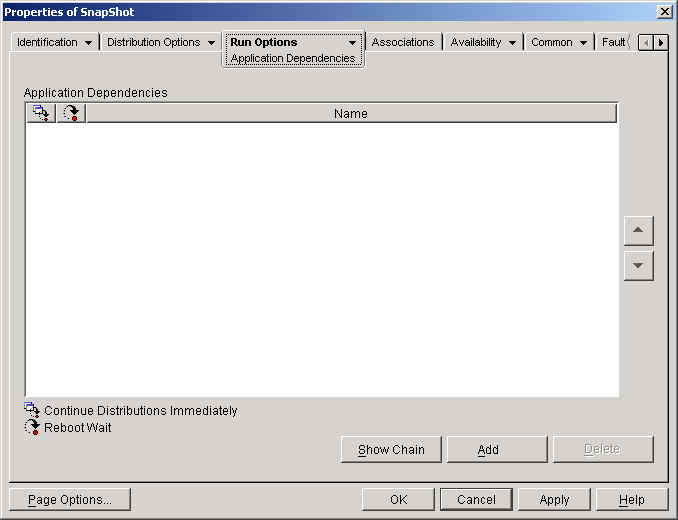
You can specify one or more dependent applications. For example, assume that the primary application (Application A) is dependent on three other applications (Application B, Application C, and Application D). By adding all three applications to the Application Dependencies list on this page, Application Launcher ensures that all three dependent applications are distributed and launched before running Application A.
A dependent application can be a single application or it can be an application chain. An application chain exists when a dependent application is dependent on additional applications. Continuing the above example, if Application C is dependent on Application C1 and Application C2, then Application B, C, C1,C2, and D must all be distributed and launched before Application A is distributed and launched.
When setting up application dependencies, you should be aware of the following:
-
Distribution: Novell Application Launcher only distributes a dependent application the first time the user launches the primary application, unless the dependent application’s version is updated (Application object > tab > page) or the distribution is unsuccessful. If Application Launcher is unable to distribute a dependent application (for example, the user’s workstation does not meet the dependent application’s system requirements), the primary application is not distributed or launched.
-
Distribution through removable media: If you distribute the primary application through removable media such as a CD (see Distributing Applications Via Removable Media) or through an image add-on (see Imaging Page), its dependent applications must be included on the removable media or as another image add-on.
-
Distribution to disconnected workstations: For workstations running in disconnected mode, the applications must be force cached to the workstation before it becomes disconnected (or they must be distributed through removable media). If changes are made to dependent applications after the applications have been cached to workstations, the version number of the primary application must be updated in order to force a re-cache of the applications.
-
Launch: Application Launcher launches a dependent application each time the primary application is launched. During launching, Application Launcher executes the dependent application’s pre-launch and post-launch scripts, and then launches the dependent application. If a dependent application, such as a setup program, should be run only one time, you should configure the dependent application to run once (Application object > tab > page).
-
Uninstall: If you uninstall the primary application ( tab > page or tab > page), all dependent applications that are not used by another application are also uninstalled.
Application Dependencies List
The Application Dependencies list displays the applications that the primary application has a dependency on. The order in which the dependent applications are listed, going from bottom to top, is the order in which they are distributed and launched on the user’s workstation when the primary application is launched.
Add
To add an application to the list, click , browse for and select the Application object, then click . After the application is added to the list, you can modify the following two attributes:
-
Continue distributions immediately: Select this option if you want Application Launcher to distribute and run the application but not wait for the application to finish running before continuing with the next application distribution.
If this option is not selected (the default), Application Launcher waits until it has distributed and run the application before continuing with the distribution of the next application in the list. Application Launcher only continues after all files, registry settings, and so forth have been distributed and the application (or file) listed in the field ( tab > page) has been run and completed.
-
Reboot wait: If distribution of the application requires the workstation to be rebooted, select this option to have Application Launcher postpone the reboot until 1) it distributes another application in the list that requires a reboot (and doesn’t have this option selected) or 2) it has distributed all applications in the list. This option also applies when uninstalling the application.
Delete
To remove a dependent application from the list, select the application in the list, then click .
Show Chain
To see whether or not a dependent application consists of an application chain, select the dependent application in the list, then click .
Up-Arrow and Down-Arrow
The order in which the dependent application are listed is the order in which they are distributed and launched, going from bottom to top. You can use the up and down arrows to change the order.